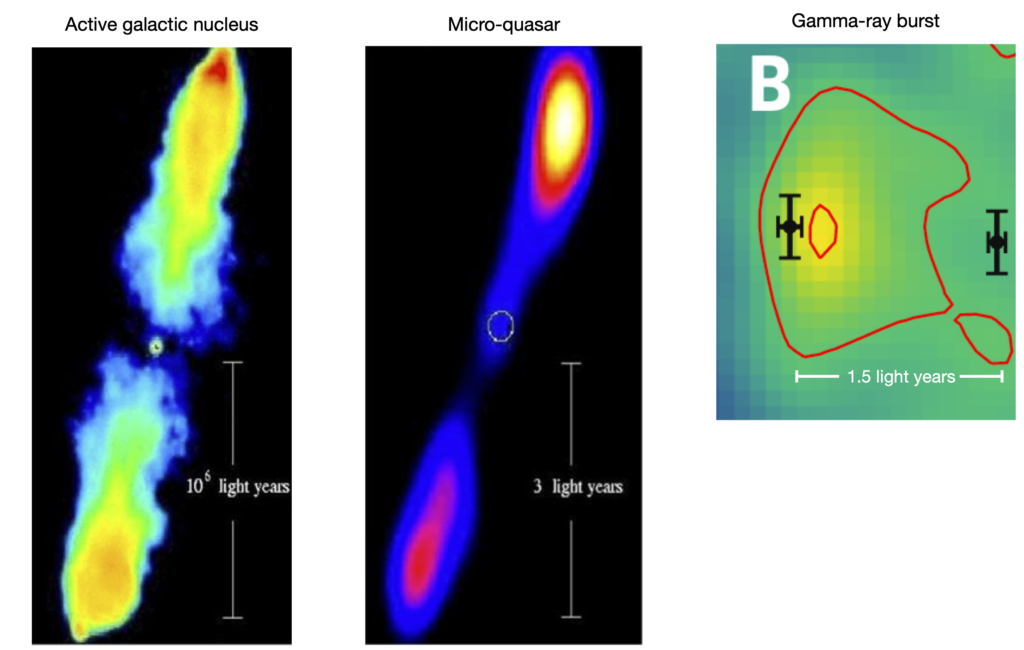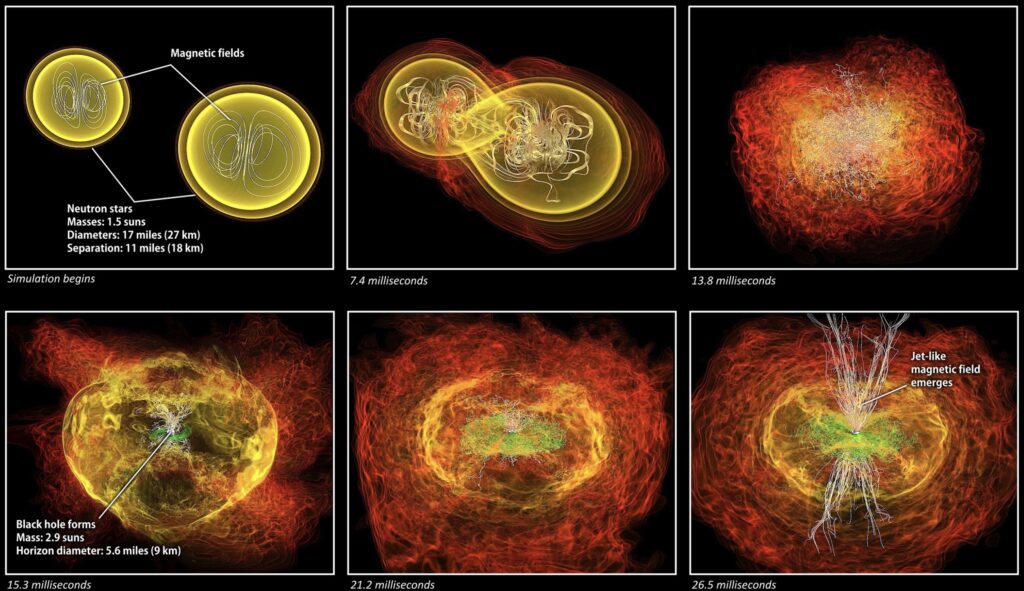Relativistic jets are collimated and extremely energetic outflows. They are ubiquitous in the Universe and observed in many astronomical contexts: in the centers of galaxies as launched by active galactic nuclei, in the form of microquasars in binary systems, or as short-lived outflows in the case of gamma-ray bursts. These phenomena, while apparently distinct in nature, are all realizations of relativistic jets, covering vastly different length and energy scales.
Despite decades of both observations and theoretical descriptions of relativistic jets, salient questions remain such as:
- What source of energy launches and accelerates jets to relativistic speeds?
- What gives relativistic jets their stability against the various instabilities at work in outflows?
- What produces low- and high-energy emission during the propagation and interaction of relativistic jets with the ambient medium?
- Are the properties of relativistic jets universal across mass scales?

The JETSET project ambitions to approach these fundamental questions in a single conceptual framework serving a comprehensive picture for the phenomenon of relativistic jets: from their launching at the smaller scales to their manifestation as astronomical signals at the larger scales.
Such a comprehensive vision of these jets can only stem from an approach combining an advanced theoretical understanding of astrophysical outflows and their context with the most accurate astronomical observations of jets. In JETSET, the theoretical understanding is realized through cutting-edge numerical simulation tools forged and matured in the team in Frankfurt, while the observations of jets benefit from the recent achievements of radio interferometry and from the recent opening of the gravitational-wave era. JETSET hosts experts in all these fields, such that we are prepared to address the above questions.
State of the art
Notwithstanding the variety of scenarios in which relativistic jets appear, it is clear that they must reflect the interplay among highly nonlinear processes involving: (i) extreme gravity and accretion onto a rotating black hole – either of stellar mass or supermassive; (ii) extraction of energy from the accretion process – either from the black hole or from the disc; (iii) acceleration of the plasma – either through hydrodynamic or dissipative processes; (iv) propagation over very large scales and suppression of instabilities – either through magnetic collimation or external confinement; (v) conversion of kinetic energy into internal energy at the breakout or in the interaction with the interstellar medium (ISM) – either via shocks or turbulent dissipation.
When considering jets from short gamma-ray bursts (GRBs), a long-awaited event took place on 2017 August 17: the LIGO and Virgo detectors recorded the signal from the inspiral and merger of a binary neutron-star system (GW170817). Less than a couple of seconds later, the gravitational-wave signal was followed by several electromagnetic emissions of a weak short GRB recorded by ∼ 70 observatories and satellites across many bands. This event has had enormous impact. First, it has marked the birth of multi-messenger gravitational-wave astronomy. Second, it has delivered the unequivocal confirmation that short GRBs are the result of merging binaries comprising at least one neutron star. Third, the kilonova emission from the ejected material has confirmed that these mergers are the production site of the heaviest elements in the universe. Finally, it has provided tighter constraints on the maximum mass and typical radii of neutron stars. Hence, in no more than three seconds, GW170817 and GRB170817A have tightened up a number of loose aspects of the dynamics of merging compact binaries.
Unfortunately – or maybe fortunately! – a number of issues still await clarification. Over the last decade, numerical simulations have played a fundamental role in elucidating the dynamics of this process. In particular, they have shown that the merger of a neutron-star binary inevitably leads to the formation of a massive metastable object, which can either collapse promptly or survive up to a fraction of a second emitting large amounts of gravitational radiation. More importantly, if the neutron stars are magnetised, the merger can lead to instabilities amplifying the magnetic field and to the formation of magnetically confined jet structures once a torus is formed around the black hole.

This is shown in the figure above, which reports a simulation that is iconic of the dynamics of this type of objects. With all the limitations of being the first simulations of this type and of employing a number of idealisations, these simulations have shown that magnetohydrodynamical (MHD) instabilities can amplify an initially weak magnetic field to produce a strong and ordered poloidal field along the black-hole spin axis, which may serve to launch a relativistic jet. However, no relativistic outflow was produced in these simulations, although a mildly relativistic wind from the torus was measured. The broad consistency with observations – in terms of timescales, energetics and geometry – of these ab-initio calculations has thus revealed that the merger of magnetised neutron stars can provide the physical conditions for the central engine of short GRBs.
Almost ten years after the simulation shown above, while progress has been achieved to confirm this description by pushing the computational capabilities to the limit with simulations at very high resolution, our understanding of how magnetised binaries lead to a relativistic jet is still very poor. An example for all: the “central engine” – i.e., the source of energy actually powering the jets – is still veiled in mystery. It is in fact unknown whether it comes from the rotational energy of the black hole (“Blandford-Znajek” mechanism), or from the accretion disc (“Blandford-Payne” mechanism), or from a radically different process, involving magnetic reconnection, or the annihilation of neutrinos from the accretion disc. Equally poorly understood are the processes leading to the collimation and stability of relativistic jets as they propagate over scales eight orders of magnitude larger than their cross section. Several scenarios have been proposed in which the jet is confined either by the thick accretion disc, or by an ordered magnetic field, or by a match in pressure with the external medium. Similarly, the role played by instabilities in the propagation is far from being settled. While it is clear that a number of them can be active, the conditions that ultimately manage to stabilise these flows are unknown. Finally, although we observe the emission from relativistic jets, we still do not know the microphysical processes responsible for it, or the role played by the interaction with the dense matter in GRBs or with the tenuous ISM in the case of active galactic nuclei.
In essence, therefore, all of the four fundamental questions above still fully apply to what we presently know (and do not know!) about relativistic jets. JETSET aims at removing these limitations – or at least at reducing them significantly – and at providing a first comprehensive view of the physics and astrophysics of relativistic jets.